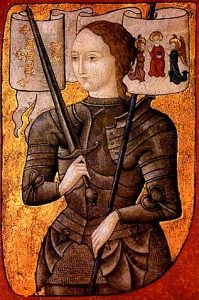Queen Margrethe I and the Kalmar Union
At this point our trip to Norway back in June seems like a distant memory, and some of the stories I planned to share with you seem equally vague. But one story resonated with me too strongly to ignore: Queen Margrethe (1353-1412), the first great ruling queen in European history.
Like many ruling queens in medieval Europe, Margrethe came to power as a queen regent not a queen regnant.
The daughter of the the King of Denmark, she was betrothed to Haakon, the king of Norway, when she was six years old for dynastic reasons. (They were married when she was ten. Being a medieval princess was not an easy gig.) By the time their only son, Olaf, was born in 1370,* Margrethe had already demonstrated talent as a ruler.
In the coming years, Margarthe proved to be a master of dynastic chess. Here are the highpoints:
• When her father died in 1375, she succeeded in getting her five-year-old son elected to the Danish throne.
• When her husband died in 1380, she became regent of both Denmark and Norway in her son’s name.
• Olaf came of age in 1385, but Margrethe continued to rule along side him. Together they prepared to go to war against Sweden to claim the Swedish crown—Olaf’s grandfather had been the king of Sweden for a time.
• Olaf died suddenly in 1387. Margrethe adopted her six-year-old nephew, Eric of Pomerania, as her heir and continued to rule Denmark and Norway as regent.
• She then went after Sweden, though the claim to the throne had died with Olaf. By 1389 she was the undisputed ruler of the three Scandinavian states, though still officially as regent.
Even after Eric’s coronation in 1396, Margrethe remained Scandinavia’s actual ruler until her death.
Margrethe’s reign shaped Scandinavia for centuries. The three Scandinavian states were united in 1397 under the Kalmar Union, which united Denmark, Norway and Sweden until 1523 and Denmark and Norway until 1814.
Mighty important for someone who didn’t show up in any of my world history classes--or in either of the two books I own titled Medieval People.
*You do the math.
In which I review Abbott Kahler’s Eden Undone
Abbott Kahler, who previously published under the name Karen Abbot, consistently writes works of narrative non-fiction that combine impeccable research, the story-telling devices of fiction, memorable characters, and impeccable prose. As a reader, I find it hard to put them down. As a writer, I marvel at her writing chops. As a reviewer, I struggle to write about them, because I don’t want to spoil any of the twists and turns.
Her newest book, Eden Undone: A True Story of Sex, Murder, and Utopia, has twists and turns aplenty and characters who blow past memorable to just plain crazy.
The book tells the story of three separate groups of Europeans who fled the fracturing world of Europe between the two world wars for the Galápagos Islands. Each group set out to create their own vision of a utopian paradise.
Kahler makes it clear from page one that their differing dreams of Utopia fail. She opens the book in 1934 with a macabre discovery on a tiny remote island in the northern part of the Galápagos: two bodies that had been mummified by the tropical sun. The two had died of thirst, leaving behind an overturned skiff, baby clothes, several photographs, and a batch of letters.
Leaving us with no hints about who the bodies were, or why they had ended up on a lava-covered island with no fresh water, she moves back several years and introduces us to the three groups who settled on the nearby island of Floreana: a German doctor with extreme ideas about health and natural living and his married lover/patient, a traumatized German veteran of the Great War and his family, and a gun-toting, riding crop-waving Austrian baroness known as “Crazy Panties” and her two young male paramours. Each of the three groups had different ideas about their island paradise should look like and conflict between them was inevitable and ultimately violent.
Eden Undone is beautifully written, intense, and creepy. A perfect book to pick up for the spooky season.
From the Archives: Joan of Arc and the French resistance
More than once in the last few years, I’ve stumbled across stories in old issues of the Chicago Tribune that caught my imagination even though they did not deal with my current project.
This headline from May 13, 1945, grabbed my attention: “FRANCE HONORS JOAN OF ARC AS ‘FIRST PARTISAN’. “
The piece began “The French paid homage today to their national heroine of five centuries, Joan of Arc, who was hailed as the ‘first of the resistants’ in military, religious and popular ceremonies.” The article went on to briefly describe the ceremonies and to point out that in prior years it had been French royalists who had celebrated the Maid of Orleans, not French republicans.
It seemed to me that with this recognition, the story of Joan of Arc had come full circle.
Over time, the phrase the “Joan of Arc of [fill in the blank]” has become shorthand for a (usually young) woman leading an army against an occupying foreign power. The term has been applied to the solidly historical Ani Pachen of Tibet and the semi-mythical Trieu Thi Trinh of third century Vietnam. The Women's Era, a popular African American women's newspaper founded in 1890, called Harriet Tubman “the Black Joan of Arc." Novelist Henry Miller heard the story of Greek nationalist Laskarina Bouboulina and asked, "How is it we don't hear more about Bouboulina? ...She sounds like another Joan of Arc." Even at the scale of a besieged city, we find a local heroine described as the “Joan of Arc of Braunschweig.” Each of these women embodied to some degree what Halina Filipowicz describes as the central element of the "Joan of Arc cult": "a deeply felt need for a democratic hero of unflinching loyalty to a patriotic mission."
Joan of Arc had long been the model against which other female resistance fighters where measured. Now it seemed the French government had turned the tables by dubbing Joan of Arc “the first of the resistants” rather than naming a woman resistance fighter “a twentieth century Joan of Arc.”*
*I almost typed “the Joan of Arc of France,” but that doesn’t work for obvious reasons.








